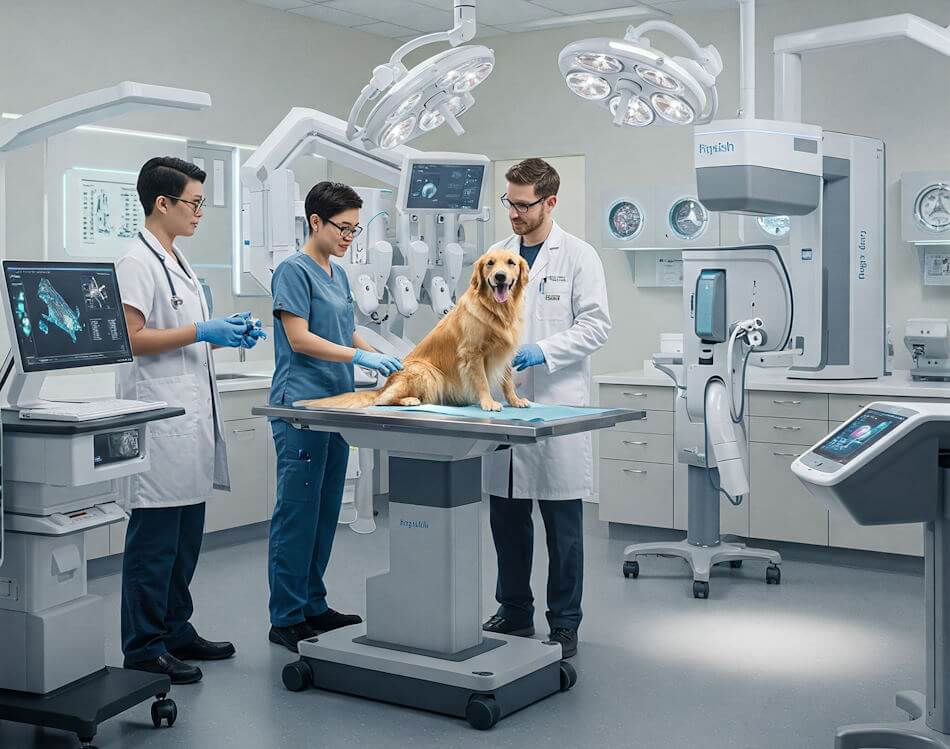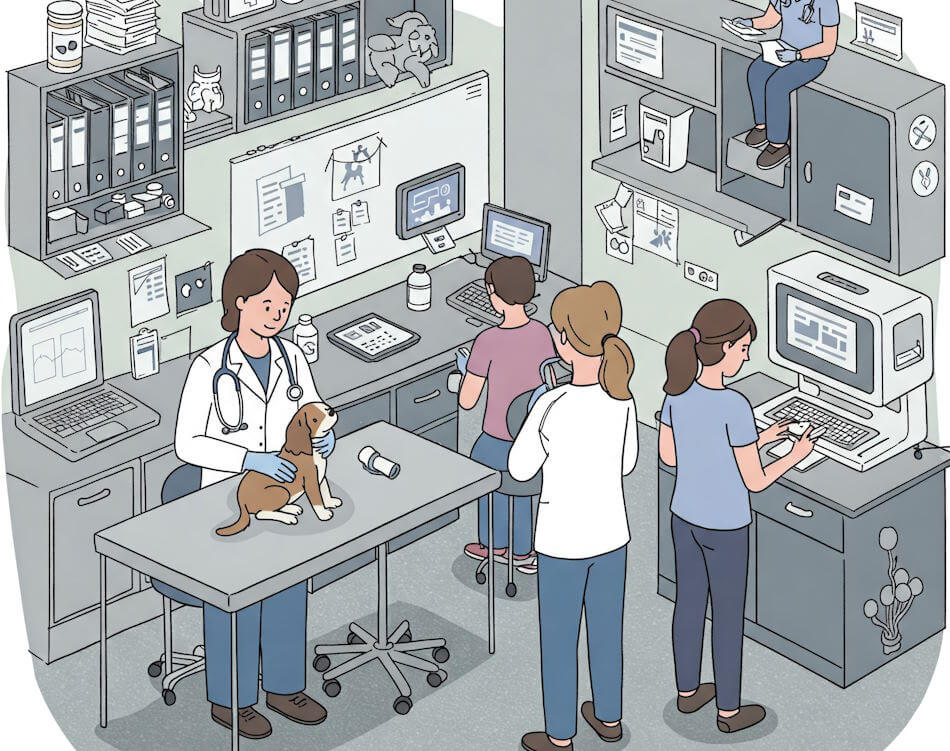Introduction to Veterinary Medicine’s Evolution
Veterinary medicine, the branch of medicine that focuses on the diagnosis, treatment, and prevention of diseases in animals, has undergone significant evolution since its inception. Historically, the practice can be traced back to ancient civilizations, where early animal healers utilized rudimentary techniques and herbs to address ailments in livestock and pets. Over the centuries, the field has expanded remarkably, propelled by advancements in science and technology, resulting in a more sophisticated understanding of animal health and welfare.
In contemporary veterinary medicine, the scope of practice has diversified significantly, encompassing not just traditional animal husbandry but also specialized fields such as surgery, dentistry, dermatology, and even emergency care. The integration of various medical disciplines has led to improved diagnostics and treatment options that mirror human health care advancements. This parallel evolution of veterinary practices reflects the increasing significance of animals in human society, whether as companions, working animals, or as part of agricultural systems.
One of the most notable trends in veterinary medicine today is the adoption of technology, including telemedicine, advanced imaging techniques, and electronic health records. These innovations not only enhance diagnostic accuracy but also improve the efficiency of animal health care delivery. With the advent of wearable devices for pets and the implementation of artificial intelligence in diagnostics, the field is poised to transform how veterinary professionals diagnose and treat animal conditions.
The continued evolution of veterinary medicine underscores the importance of adapting to new challenges, such as emerging infectious diseases, climate change, and the growing demand for animal products. The integration of innovations and technology is essential to effectively manage these challenges and ensure the best possible outcomes for animal health. As the field progresses, staying informed about these developments is crucial for veterinary practitioners, animal owners, and stakeholders in the broader animal care community.
Telemedicine in Veterinary Practice
Telemedicine is rapidly evolving as a vital component in veterinary practice, providing unprecedented access to care for pet owners and their beloved animals. As the field of veterinary medicine continues to adapt to technological advancements, virtual consultations have emerged as a practical solution that bridges the gap between veterinarians and pet patients. This approach allows for real-time communication, enabling pet owners to connect with their veterinary professionals from the comfort of their homes. By utilizing video calls and telecommunication tools, veterinarians can assess symptoms, provide medical advice, and recommend treatment options without requiring an immediate in-person visit.
The advantages of telemedicine in veterinary care are manifold. Firstly, it enhances accessibility, especially for those living in rural areas or for pet owners who face transportation challenges. Remote monitoring tools and wearable technology further support this service by allowing clinicians to track pets’ health metrics and monitor their conditions over extended periods. This continuity of care can significantly improve outcomes, as early interventions can be made based on data collected through remote assessments.
However, the adoption of telemedicine does not come without its challenges. Regulatory frameworks governing telehealth services in veterinary medicine often lag behind technological innovations. Different regions have unique laws related to telemedicine, and not all veterinarians are permitted to diagnose or prescribe treatment without a prior physical examination. Consequently, these regulatory hurdles can limit the full potential of telehealth services in veterinary care.
Looking towards the future, the integration of telemedicine in veterinary practice appears promising. As regulations evolve and technology continues to advance, the capabilities of virtual care are expected to expand. More veterinarians may find their practices augmented by telemedicine, creating a more flexible, efficient, and effective approach to delivering veterinary care.
Advancements in Diagnostic Technologies
The field of veterinary medicine has witnessed substantial advancements in diagnostic technologies, which have revolutionized the approach to animal health care. Among the most significant developments are AI-driven imaging systems, genetic testing methodologies, and biomarker identification techniques. Each of these innovations plays a crucial role in enhancing the early detection of diseases and improving overall treatment outcomes.
AI-driven imaging technologies have introduced remarkable efficiencies in diagnostic procedures. These systems utilize sophisticated algorithms to analyze imaging data, such as X-rays and ultrasounds, allowing for quicker and more accurate diagnoses. The incorporation of artificial intelligence in veterinary imaging significantly reduces diagnostic errors, leading to timely interventions that can make a difference in critical cases. As a result, veterinarians can provide more tailored treatment plans that cater to the specific needs of their animal patients.
Additionally, genetic testing has emerged as a pivotal tool in veterinary diagnostics. This technology offers insights into hereditary conditions and can predict an animal’s predisposition to certain diseases. Understanding genetic predispositions enables veterinarians to implement preventive measures and tailored health management strategies that enhance the longevity and quality of life for pets. Moreover, advancements in biomarker identification facilitate the tracking of disease progression and response to treatment, allowing for real-time adjustments in therapy.
However, these innovative diagnostic technologies come with challenges that must be addressed for successful implementation. Data management, including the handling of sensitive genetic and health information, raises concerns about privacy and security. Furthermore, the integration of these systems into existing veterinary practices requires comprehensive training for practitioners to ensure they can leverage technology effectively. Addressing these challenges will be critical to fully realizing the benefits of advancements in diagnostic technologies within the veterinary field.
The Role of Artificial Intelligence and Machine Learning
The integration of artificial intelligence (AI) and machine learning in veterinary medicine is reshaping the landscape of animal healthcare. These advanced technologies offer innovative solutions that can enhance diagnostics, treatment protocols, and operational efficiencies within veterinary practices. One significant application of AI is in predictive analytics, which enables veterinarians to anticipate potential disease outbreaks by analyzing vast amounts of data. Through machine learning algorithms, these systems can identify patterns and correlations that may not be immediately apparent, allowing for timely interventions that could save lives and resources.
Moreover, AI plays a pivotal role in improving treatment protocols. By leveraging machine learning, veterinarians can access historical health data of similar cases, providing insights that inform personalized treatment options. This approach is not only beneficial in enhancing outcomes for individual animals but also promotes evidence-based practices across the field of veterinary medicine. AI-driven systems can facilitate the analysis of diagnostic images, leading to quicker and more accurate assessments which are crucial for effective treatment planning.
In addition to these advancements, AI technologies enhance operational efficiency in veterinary practices. Automation of routine tasks, such as appointment scheduling and inventory management, allows veterinary staff to focus more on patient care rather than administrative burdens. However, it is essential to consider the ethical implications of AI in this context. Maintaining data privacy, ensuring the accuracy of machine learning models, and addressing the potential for bias in algorithms are vital factors that must be diligently managed as these technologies evolve. Looking ahead, the potential for AI and machine learning in veterinary medicine is vast, promising to improve the quality of care and streamline veterinary operations while ensuring that ethical standards are upheld.
Preventive Care and Wellness Innovations
The field of veterinary medicine is undergoing significant transformation, particularly in the realm of preventive care and wellness. Innovative approaches are being developed to address the unique health needs of pets and align with the growing expectations of pet owners for comprehensive care. One noteworthy advancement is the introduction of wearable health monitors. These devices enable pet owners to track their animals’ health metrics in real-time, providing valuable data regarding vital signs, physical activity levels, and general behavior. By utilizing this technology, veterinarians can gain insights that facilitate early detection of potential health issues, ensuring prompt intervention.
Another significant development in preventive care is the creation of personalized vaccination schedules. Traditionally, vaccination regimens followed a one-size-fits-all approach, but emerging research suggests that individual factors such as breed, age, and pre-existing medical conditions play a crucial role in determining the most effective vaccination plan. Tailoring vaccinations to the specific needs of each pet helps enhance their immunity and reduces the risk of vaccine-related complications, thereby contributing to better long-term health outcomes.
Furthermore, the rise of lifestyle-related wellness programs marks a noteworthy trend in veterinary medicine. Such programs advocate for a holistic approach, addressing not just the immediate medical needs of pets, but also their overall quality of life. These initiatives often include nutritional counseling, exercise regimes, and mental stimulation, all aimed at promoting longevity and preventing common health issues. By emphasizing the significance of preventive care, veterinary professionals are not only improving individual pet outcomes but also fostering a healthier pet population overall. Innovations in preventive care are increasingly important as they help meet the evolving expectations of pet owners, who are becoming more engaged in ensuring their pets’ health and well-being.
Integrative and Holistic Approaches
In recent years, there has been a notable shift towards integrative and holistic approaches in veterinary medicine, with practitioners increasingly recognizing the benefits of combining traditional methods with alternative therapies. This trend is driven by a growing awareness among pet owners regarding the overall well-being of their animals. The aim of such methodologies is not only to treat specific ailments but also to enhance the animal’s quality of life by considering its physical, emotional, and environmental factors.
Acupuncture, chiropractic, and herbal medicine are among the most commonly integrated therapies within veterinary care. Acupuncture, which involves inserting fine needles into specific points on the body, has gained popularity for its efficacy in managing pain, reducing inflammation, and promoting healing. It is especially favored for its non-invasive nature and minimal side effects. Similarly, chiropractic adjustments have been recognized for their ability to alleviate musculoskeletal issues, providing greater mobility and comfort to animals, particularly those recovering from injuries or suffering from chronic conditions.
Herbal medicine is another component of holistic approaches, involving the use of plant-based remedies to support the body’s natural healing processes. Many veterinarians now incorporate herbal supplements into their treatment plans, allowing for an individualized approach based on each animal’s unique needs. This reflects a broader acceptance of complementary treatments within veterinary practices, fostering a collaborative atmosphere where veterinarians and clients can discuss various therapeutic options.
The shift towards integrative care also enhances the veterinarian-client relationship. Pet owners are more engaged in their animals’ health decisions and often seek to understand the underlying factors contributing to their pets’ conditions. This collaborative approach empowers clients, promotes informed decision-making, and ultimately leads to improved health outcomes for the animals. By embracing integrative and holistic practices, veterinary medicine is evolving to meet the needs of modern pet owners and their companions. This progressive model of care underscores the importance of treating animals as whole beings, paving the way for a future where diverse therapeutic options enhance veterinary care.
Sustainability and Ethical Practices in Veterinary Medicine
As societal awareness regarding environmental issues increases, the veterinary field is progressively embracing sustainability and ethical practices. This evolving perspective emphasizes the intersection of animal health, environmental integrity, and responsible pet ownership. One significant trend involves eco-friendly practices that veterinary clinics and professionals are implementing to reduce their carbon footprint. By adopting practices such as recycling medical waste, using environmentally safe products, and optimizing energy use within facilities, the veterinary industry demonstrates a commitment to both animal welfare and ecological sustainability.
Additionally, responsible pet ownership plays a crucial role in advancing sustainability within veterinary medicine. Educating pet owners about proper nutrition, preventive healthcare, and the importance of spaying or neutering pets can significantly impact population control and health outcomes. Programs that advocate for adoption over breeding, as well as the promotion of humane treatment of all animals, align with the broader goal of fostering a compassionate environment for both pets and wildlife. Moreover, veterinarians frequently find themselves at the forefront of ethical debates, as they guide owners in making decisions that prioritize the welfare of their animals while also considering the implications for public health and the environment.
The veterinary industry is increasingly leveraging innovative technologies to reduce its environmental impact. For example, digital record-keeping and telemedicine have transformed traditional practices, allowing for a decrease in paper usage and promoting remote consultations. Additionally, the development of sustainable products, such as biodegradable surgical materials, highlights the commitment to reducing waste and improving animal welfare. Emphasizing transparency and ethical decision-making is essential, as practitioners navigate the complexities associated with providing care in a manner that respects both animals and their habitats. The future of veterinary medicine will undoubtedly hinge on these vital aspects of sustainability and ethics.
The Impact of Data and Analytics on Veterinary Care
The integration of data and analytics is poised to revolutionize veterinary medicine, offering tremendous potential for enhanced decision-making, improved surgical outcomes, and increased client engagement. Veterinary practices increasingly harness data-driven technologies, streamlining operations and optimizing animal care through informed analyses. By implementing electronic health records (EHRs), veterinary professionals can access comprehensive medical histories and treatment protocols, facilitating more precise diagnoses and tailored treatment plans.
Data analytics proves indispensable in surgical settings as well. With the ability to evaluate historical outcomes and real-time monitoring, veterinarians can make informed decisions regarding anesthesia protocols and surgical techniques. This could lead to reduced complications and higher success rates in surgeries. Furthermore, the ability to analyze patterns in data allows for proactive interventions, thus addressing health issues before they escalate into serious conditions.
Client engagement also stands to benefit significantly from data utilization. Customized communications based on pet health data can enhance the client experience, fostering loyalty and adherence to treatment plans. For instance, reminders for vaccinations or wellness checks can be automated, ensuring pets receive timely care, which contributes positively to overall animal health management.
However, the shift towards data-centric veterinary medicine does not come without challenges. Data privacy concerns are prominent, as practices must be vigilant in safeguarding sensitive client and patient information. Moreover, integrating data from disparate sources into cohesive systems poses logistical challenges. Nonetheless, the promise of big data in transforming veterinary care is evident; it not only helps in identifying trends and predicting health issues but also paves the way for evidence-based practices. Embracing these changes is crucial for advancing the future landscape of veterinary medicine, ultimately leading to better healthcare outcomes for animals and their owners alike.
Conclusion and Future Outlook
The field of veterinary medicine is undergoing significant transformation, driven by technological advancements, evolving veterinary practices, and a growing emphasis on animal welfare. Throughout this blog post, we have explored various trends and innovations that are shaping the future of veterinary medicine, including telemedicine, personalized care, and the role of artificial intelligence. These developments not only enhance the ways in which veterinarians diagnose and treat diseases but also improve accessibility for pet owners seeking care for their animals.
As we look ahead, it is crucial for veterinary professionals to remain committed to continuous learning and professional development. The pace of change in veterinary medicine necessitates that practitioners stay informed about emerging technologies and practices. This ongoing education will enable them to adopt new tools and methodologies that improve patient care and operational efficiency. By integrating advanced technologies, such as telehealth solutions and electronic health records, veterinary clinics can streamline processes and provide better care options, adapting to the dynamic expectations of pet owners.
Moreover, the importance of collaboration among veterinary professionals cannot be overstated. Working together with colleagues from different specialties and engaging in interdisciplinary partnerships will foster the sharing of knowledge and resources, ultimately benefiting the health of animals. Veterinary professionals must also maintain open lines of communication with pet owners, facilitating discussions about the best treatment options and practices to promote the overall well-being of their animals.
In conclusion, the future of veterinary medicine holds exciting possibilities, driven by innovations aimed at enhancing animal health and welfare. By embracing change and fostering a culture of collaboration and education, veterinarians can ensure they meet the evolving needs of animals and their owners in this rapidly advancing field.





